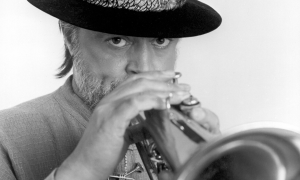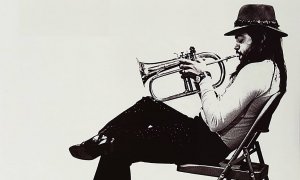Home » Jazz Articles » Catching Up With » Meet Mulgrew Miller
Meet Mulgrew Miller
In a trio or quintet, I sometimes tend to become more focused on melodic improvising. And especially in a quintet, I'll have a more concise approach to playing. But as a solo performer, I try to be more orchestral and use more of the entire instrument.
All About Jazz: You were born in Greenwood, Mississippi, and grew up listening to blues, gospel and R&B music. What attracted you to jazz?
Mulgrew Miller: The thing that pulled me toward jazz was jazz itself. By the time I really discovered what jazz was all about, I'd been playing rhythm and blues-mostly for dances. And I'd played gospel music in my church since childhood. In fact, just about all the music I played growing up was permeated with blues and gospel. I was also studying classical music, and in high school I had a trio. We played at cocktail parties, but we really didn't know what we were doing. We were going toward jazz, but we really didn't know how to approach it.
But the thing that really did it was seeing Oscar Peterson play on a TV show. When I saw him, I realized there was a way to do something with music—and do it with integrity and in a way that demanded virtuosity but wasn't classically oriented.
AAJ: Attending Memphis State University was a real key to your development as a jazz pianist, wasn't it?
MM: I met James Williams and Donald Brown while I was Memphis State, and they became very good friends as well as fine professional jazz pianists as well. We'd go together to hear Phineas Newborn, Jr. quite often. On weekends, he'd be playing at a local club called the Gemini. So that's where I really began to seriously learn jazz.
AAJ: Your first high profile job as a jazz musician was with the Duke Ellington Orchestra, right?
MM: Yes, I was asked to join the Ellington band in 1977, but I had subbed for the band's regular pianist while I was still at Memphis State. After I graduated I went to Boston, then to Los Angeles. I ran into the band again and they asked me to play with them for three weeks. It turned into three years.
AAJ: Being part of the Ellington band must have been a real learning experience.
MM: It was—both musically and personally. I was only 21 years old when I joined. It was a real experience working in a big band, and especially with Ellington's music. And touring with a big band and all the different personalities definitely was a unique experience too.
AAJ: From the Ellington band you went directly into playing for singer Betty Carter and her trio. How did that happen?
MM: I had gotten to know Cedar Walton, and it turned out both he and James Williams recommended me to Betty. She called, and that was a real turning point for me in my career because that was when I actually moved to New York City. That's when I got into a whole different kind of circus— the New York jazz scene. And I've been in that circus ever since.
AAJ: You spent eight months with Betty Carter, then moved on to join Woody Shaw's band. He's certainly been a very underrated musician in terms of his contributions to jazz, hasn't he?
MM: No doubt about it. Woody Shaw wasn't merely a great trumpet player and bandleader. He was a visionary. He certainly left his mark on the jazz repertoire in terms of compositions. And he also left his mark on the language of jazz in terms of the trumpet. I'm thinking of the way he was dealing with music—the language that he used when improvising really explored new areas on the trumpet that hadn't been dealt with before, at least at that level of sophistication. And his compositions were very forward-looking in terms of harmonic colors.
AAJ: After working with Woody, you joined Art Blakey's Jazz Messengers...
MM: Actually, I had a short stint playing with Johnny Griffin, then Art Blakey called me to join the Messengers. Then Tony Williams asked me to be a part of the new band he was putting together to record for Blue Note. And I was with Tony almost seven years. So from the Ellington band through Tony Williams, I was literally in a band every single day for 16 years.
AAJ: But somehow you eventually managed to get your own career going as a leader while doing all that. Tony Williams didn't tour nearly as much as the other leaders you played for. Did that give you the time to get your own groups going?
MM: I would say my work as a leader actually started the last year I was with the Messengers, and then really picked up when I was with Tony. So that coincided with doing my initial recordings for the Landmark label in 1985.
AAJ: You've recorded 10 albums as a leader, and worked in a variety of contexts, from a basic trio to the quintet lineup on Wingspan that featured alto sax and vibes. Looking back, do you have a favorite among those recordings—or a preferred lineup?
MM: No, in terms of both recordings and lineups. There are moments on each of those recordings that if I could pick and choose and put together, I'd have something I could really brag about. But there isn't a specific recording I think stands out. And I like both the trio and quintet formats. I still have a regular trio with Richie Goods on bass and Karriem Riggins on drums. And for my Wingspan Quintet I add Steve Wilson on alto sax and Steve Nelson on vibraphone.
AAJ: Given the consistent critical acclaim for your recordings as a leader, it's surprising that your last one, Getting to Know You, came out back in 1995. Surely you've received offers to record. Why have you chosen not to?
MM: I have had several offers, but I haven't pursued them aggressively. Some have been better than others, but I haven't had any really strong, concrete offers that seem rewarding enough to me. You know, I've made enough recordings already. I don't have to do a free record for anybody.
AAJ: Clearly the recording industry—especially in jazz—has a pretty dismal track record in providing the quality of support and distribution needed to give these recordings a decent shot to make it in the marketplace. Some jazz musicians like Gary Bartz have resorted to starting their own independent labels to issue their music. Have you thought of doing that?
MM: Well, first of all, we could do a whole interview on this subject. Let's just say the record industry is totally screwed up. And I have entertained thoughts about putting my own records out. But I'm not sure if I have both the focus and the time to get involved in a complex project like that.
AAJ: How do you approach performing solo? Do you have a set program, or do you just go with the flow?
MM: I'll have a general outline in terms of repertoire of what I'm going to play before I start. But sometimes I'll make spur-of-the-moment decisions to change what I'm going to perform. There are a lot of factors that will determine that, from the type of venue where I'm performing to the reaction of the audience.
AAJ: From a technical standpoint, how does your keyboard approach change from a quintet or trio setting to a solo performance?
MM: In a trio or quintet, I sometimes tend to become more focused on melodic improvising. And especially in a quintet, I'll have a more concise approach to playing. But as a solo performer, I try to be more orchestral and use more of the entire instrument. After all, it's just you, so you need to come up with different things to make the music more interesting. In essence, I do things that are more pianistic.
AAJ: You've been appearing on quite a few recordings lately, from releases by Diane Reeves and Rene Marie to Steve Turre and Gary Burton, Aside from your regular groups, anything else new?
MM: For the last couple of years I've been doing duo appearances with the Danish bassist, Niels-Henning Orsted Pedersen. We started working together as a result of the Ellington centennial celebration. Nils was asked to do a recording to commemorate the bass/piano duos of Ellington and Jimmy Blanton, and he called me to work with him. We've been doing some European concerts since then, and working with him in a duo setting is especially great.
Tags
Interview
Mulgrew Miller
AAJ Staff
oscar peterson
James Williams
Donald Brown
Phineas Newborn Jr.
Boston
Los Angeles
Betty Carter
Cedar Walton
Woody Shaw
Johnny Griffin
Art Blakey
Tony Williams
Gary Bartz
Diane Reeves
Rene Marie
Steve Turre
Gary Burton
Niels-Henning Orsted Pedersen
Jimmy Blanton
Richie Goods
Karriem Riggins
PREVIOUS / NEXT
Support All About Jazz
 All About Jazz has been a pillar of jazz since 1995, championing it as an art form and, more importantly, supporting the musicians who make it. Our enduring commitment has made "AAJ" one of the most culturally important websites of its kind, read by hundreds of thousands of fans, musicians and industry figures every month.
All About Jazz has been a pillar of jazz since 1995, championing it as an art form and, more importantly, supporting the musicians who make it. Our enduring commitment has made "AAJ" one of the most culturally important websites of its kind, read by hundreds of thousands of fans, musicians and industry figures every month.





















